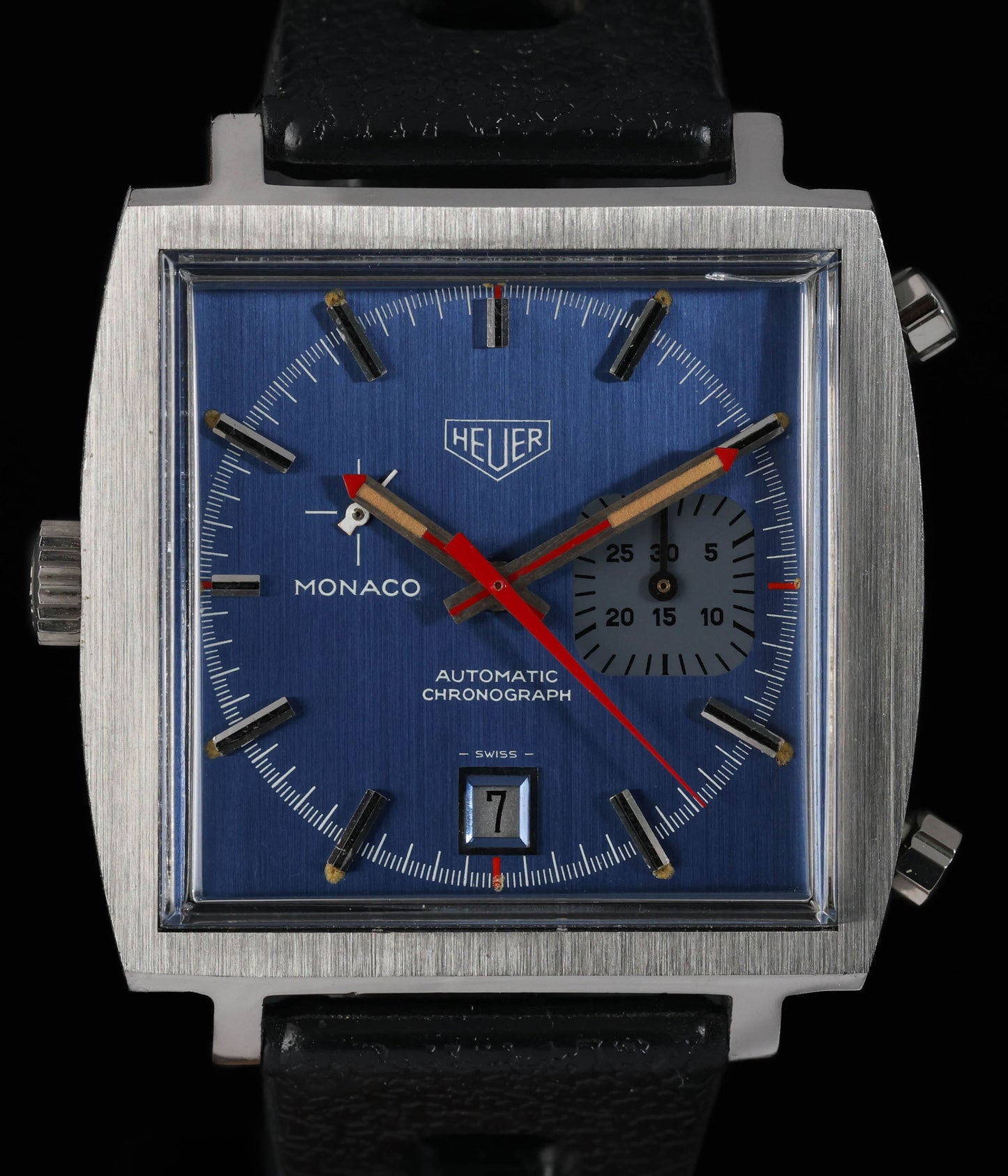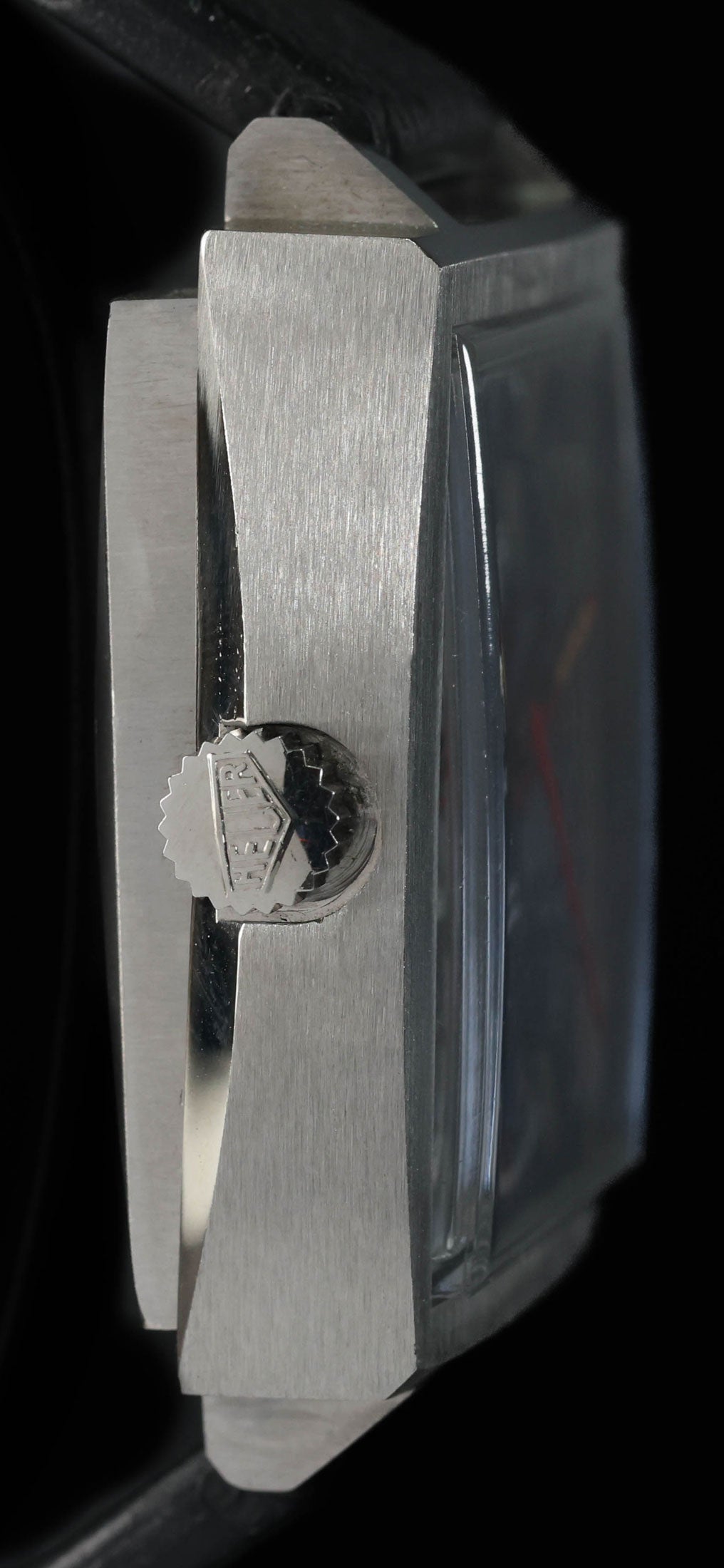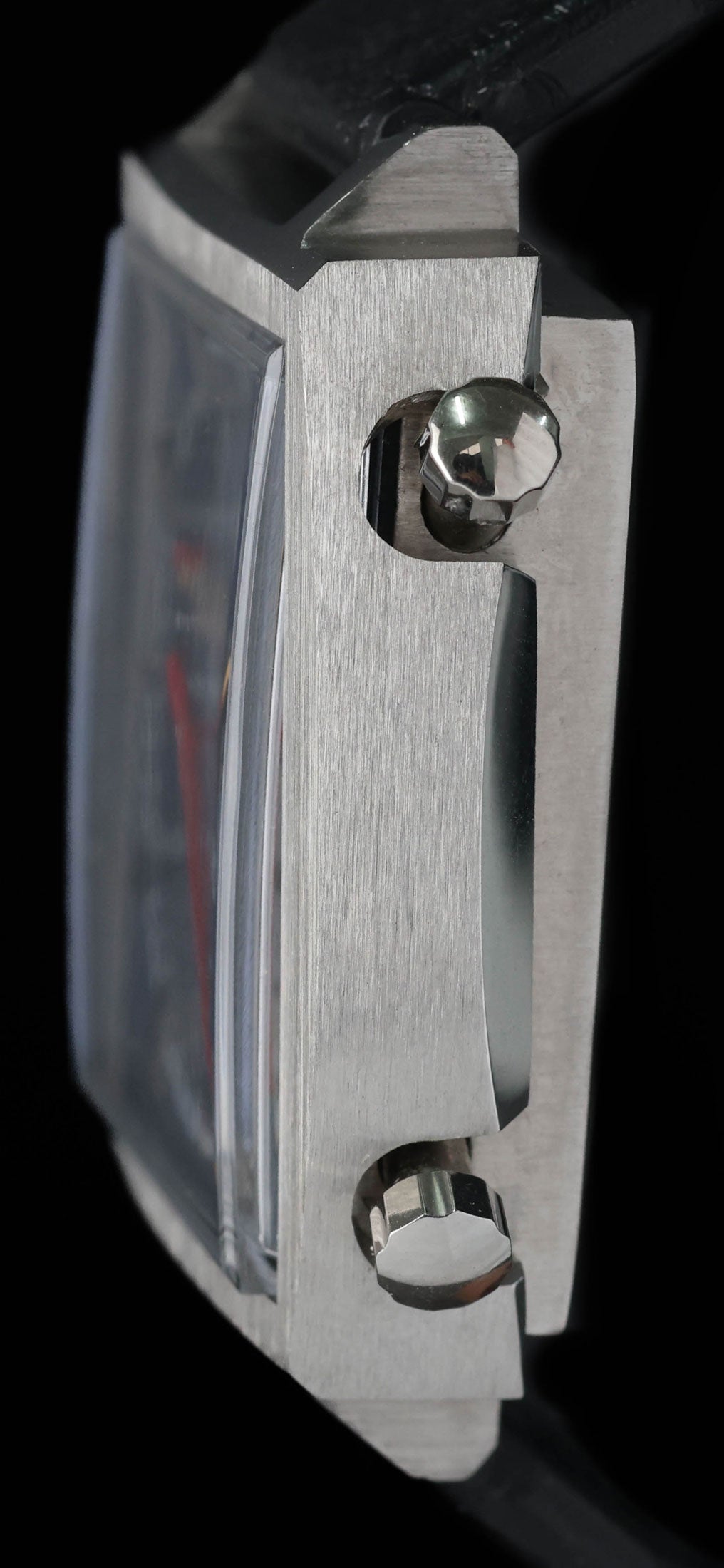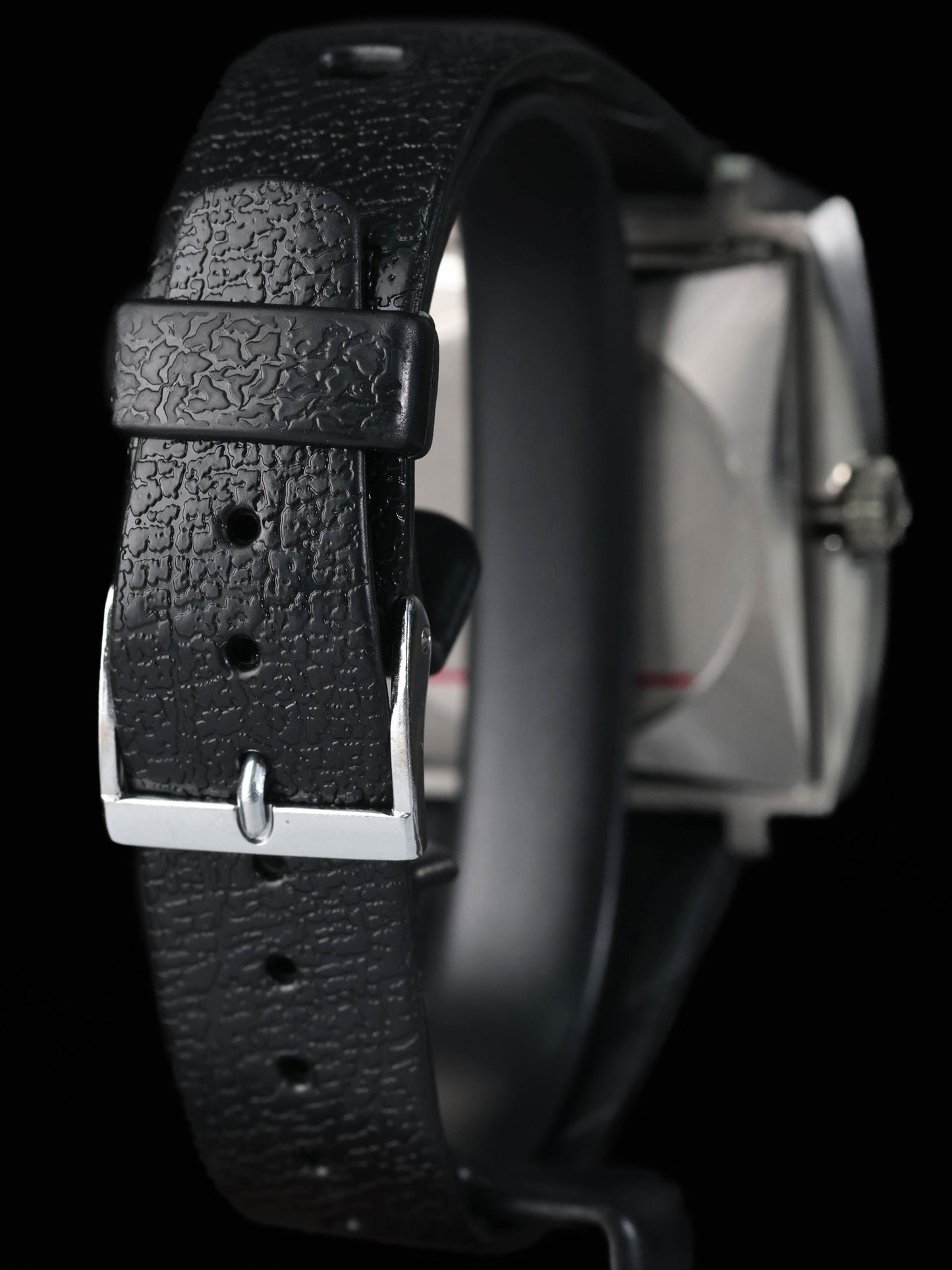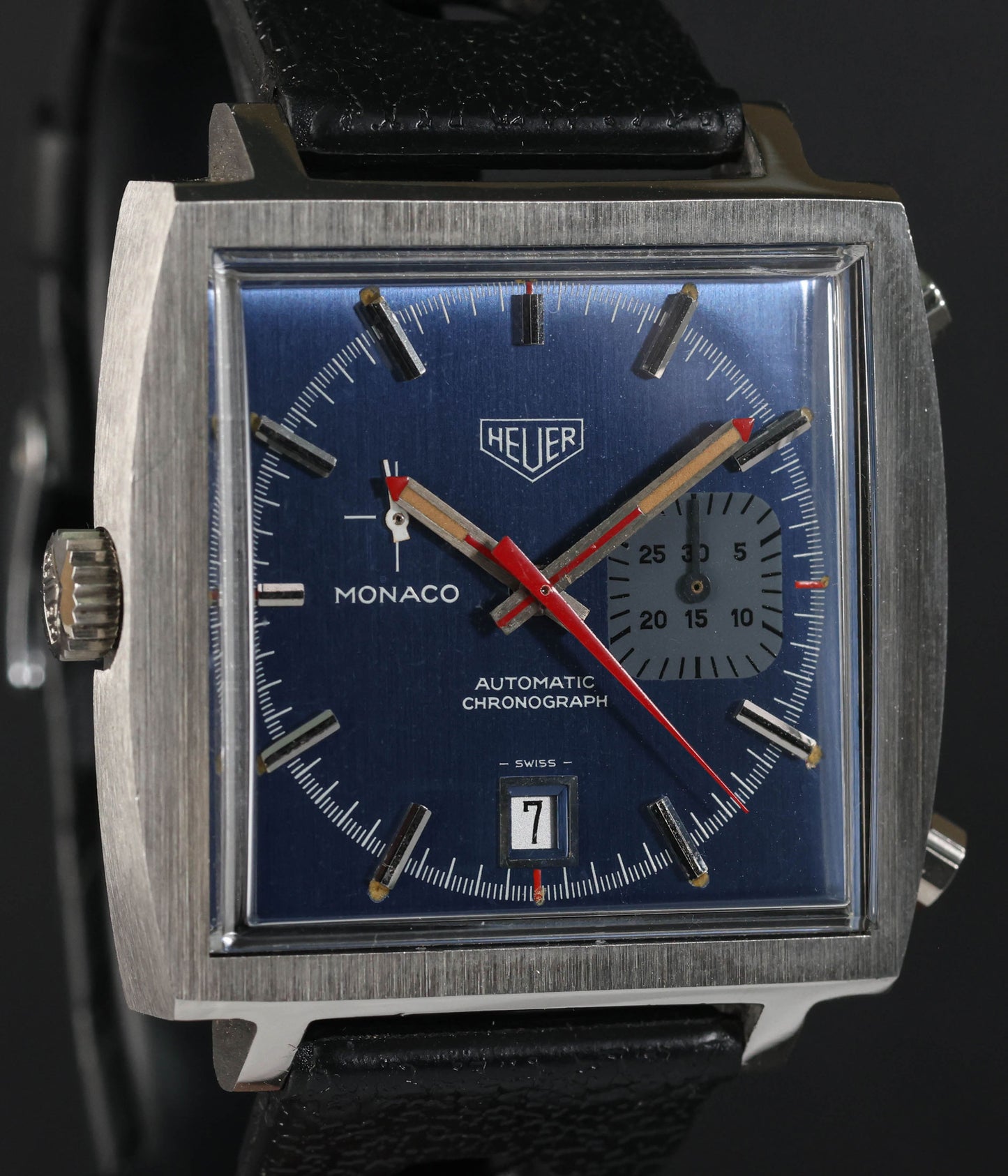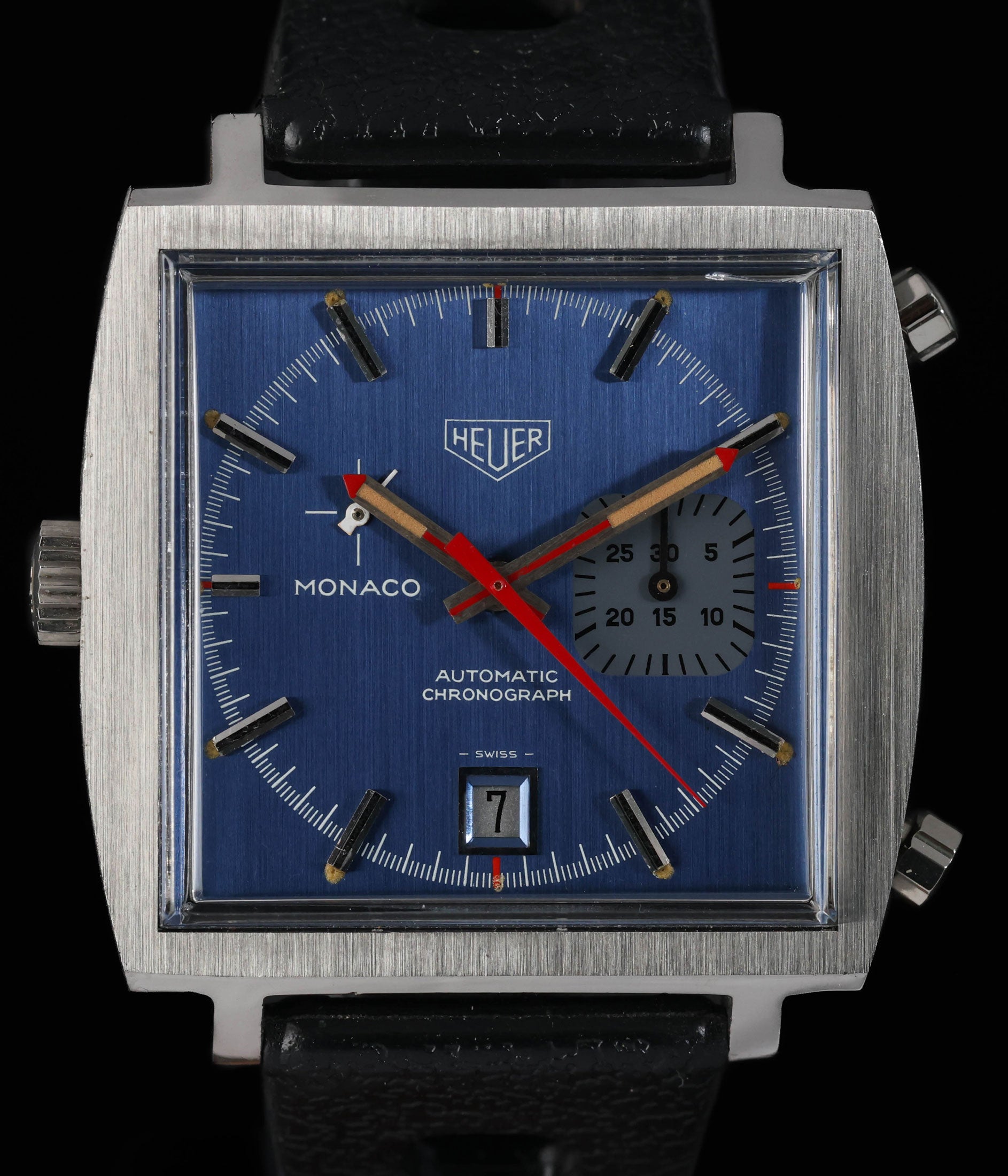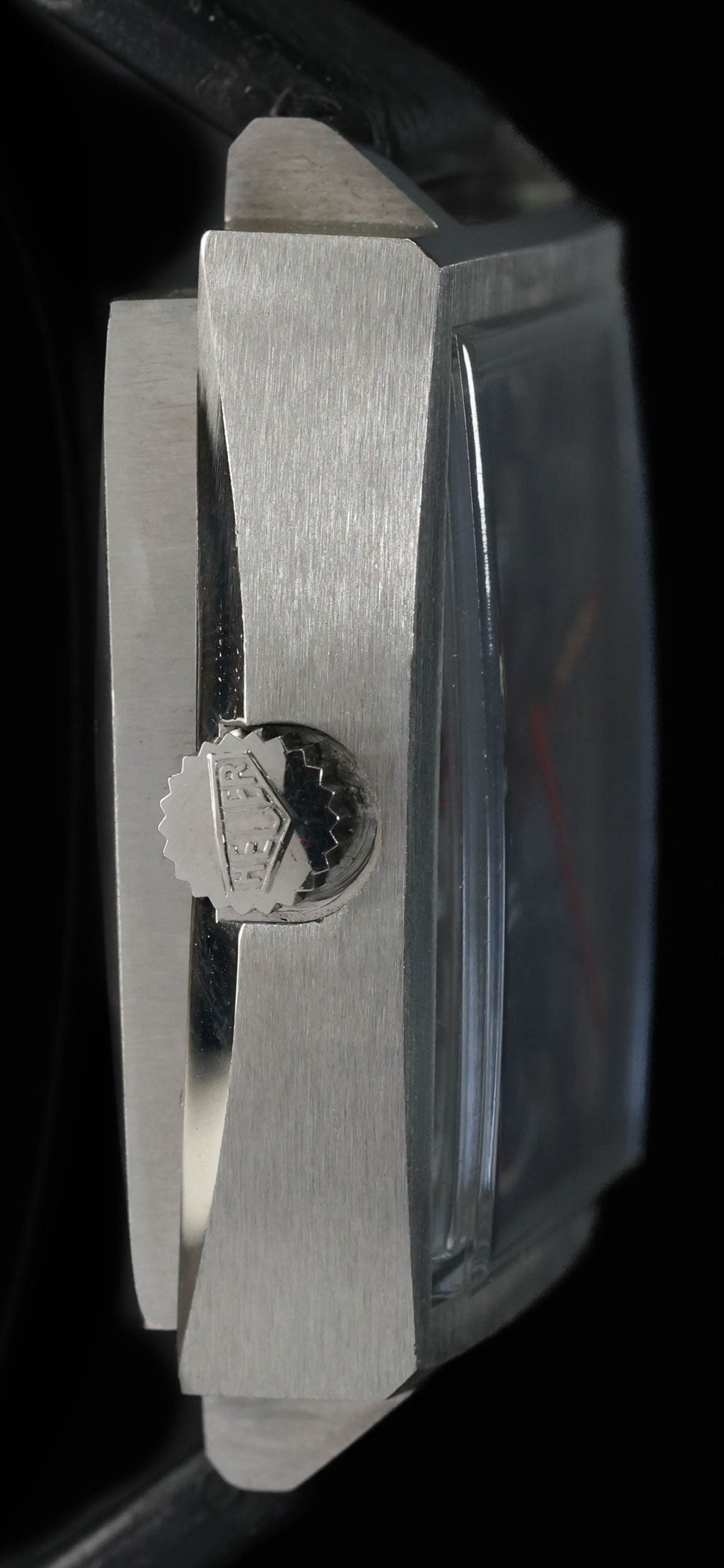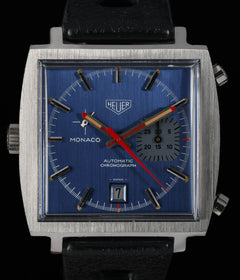Crown Vintage
Heuer Monaco 1533B 40mm Circa 1972
Heuer Monaco 1533B 40mm Circa 1972
Couldn't load pickup availability
Heuer Monaco 1533B
The stainless‑steel case presents in excellent overall condition, with sharp edges, well‑defined brushing and only the lightest hairlines visible under magnification. The period correct leather strap remains in very good condition consistent with careful wear. Dial and hands are likewise very good, their tritium plots and inserts showing a consistent, attractive creamy patina that complements the deep blue ground; all printing is crisp and free from loss. Acrylic crystal is clear with no significant chips, and pushers and crown operate smoothly. Overall, the watch displays only modest signs of age and has clearly been well preserved and an exceptional example of a very rare reference.
Share
Why we love this watch
Why we love this watch
Heuer Monaco 1533B: A Deep‑Dive into the Blue‑Dial Calibre 15 Era
When the Heuer Monaco broke cover at Basel in 1969 it looked like nothing else on the market: a waterproof square case, left‑hand crown, vivid metallic blue dial and the world’s first commercially available self‑winding chronograph movement. That debut reference, the 1133B, owes much of its modern fame to Steve McQueen’s wrist in the film Le Mans, yet the Monaco story did not stand still after the cameras stopped rolling. Rising production costs, a strengthening Swiss franc and fierce price competition forced Heuer to pivot quickly, giving birth to a short‑lived but historically important offshoot—the Monaco 1533B. Produced largely in 1972 and 1973, this blue‑dial model introduced the Calibre 15 movement and an asymmetric dial layout, marking a distinct second chapter in the original Monaco line.
From the outset Jack Heuer intended the Monaco to articulate avant‑garde design and technical bravado. The waterproof square case, patented by case‑maker Erwin Piquerez, clipped a monocoque mid‑case into a tensioned steel back; opening it required a special “Tool 033” spanner, underlining how different the watch was from Heuer’s round‑cased Carrera or Autavia. In 1969 the watch launched with the modular Calibre 11, a joint project with Büren, Breitling and Dubois‑Déprat that mounted a chronograph module atop a micro‑rotor base. Just two years later Heuer upgraded to Calibre 12, raising the beat rate from 19,800 to 21,600 vph in the search for improved accuracy, but by late 1971 another problem loomed: price. The Swiss franc had appreciated nearly forty per cent against the US dollar within eighteen months, doubling retail prices in Heuer’s biggest export market and imperilling its competitive edge.
Jack Heuer’s answer was the Calibre 15 programme. By removing the twelve‑hour chronograph wheel and simplifying several key components Heiniger’s engineers stripped cost out of the design while retaining the trademark left‑side crown and micro‑rotor automatic winding system. The trade‑off was a single thirty‑minute counter at three o’clock and an unusual small‑seconds register pushed high up the dial at about ten o’clock, an arrangement never before seen on a production chronograph. In Monaco guise the result was reference 1533—suffix B for blue, G for grey—which took its bow in the 1972 catalogue at a price roughly fifteen per cent lower than the outgoing 1133.
The 1533B kept the Monaco’s now‑familiar 40 mm × 38 mm stainless‑steel shell and plexiglass crystal, but the dial underwent a subtle makeover. Applied steel indices now radiated outwards rather than lying parallel to the case edges, bringing a sense of movement that complemented the slanted white minute hashes framing the square. Colour remained a vivid, slightly iridescent cobalt—Heuer called it “midnight blue”—while the single chronograph sub‑dial stayed white for maximum legibility. The date aperture at six echoed the earlier 1133, but the dial script changed from “Chronomatic” or “Automatic Chronograph” to a simple two‑line “Heuer” and “Automatic Chronograph”, acknowledging that the Chronomatic trademark was by then exclusive to Breitling.
Turning the watch over, the case back retained its engraved reference between the lugs though examples exist with and without a separate letter suffix. Production serials appear to run from the mid‑2.5 million range into the low‑2.6 millions, matching Heuer’s 1972–73 assembly logs, yet exact numbers are hard to pin down because the company grouped Calibre 15 components with standard Calibre 11/12 stock on the assembly line. Contemporary Heuer service guides list the Monaco 1533 alongside Calibre 15 Carreras and Autavias, hinting at modest volumes; most historians estimate no more than 1,500 blue‑dial pieces left the factory before the final Monaco deliveries in 1974.
Calibre 15 itself deserves closer examination. Although often labelled a “cut‑down” movement, the calibre was anything but crude. The base Büren 1282 microrotor plate retained its 42‑hour reserve and bidirectional winding, while the Dubois‑Déprat module kept column‑wheel actuation for the start–stop–reset sequence. To create space for the micro‑rotor and date mechanism, Dubois engineers shifted the running seconds to a satellite pinion and deleted the hour recorder entirely, leaving an empty footprint above nine o’clock. Rather than leave a blank expanse, Heuer’s design team chose to display the seconds in that space, producing the visually arresting “wide‑eyed” dial that has become the 1533’s signature. The movement finished in the same silvery rhodium plate seen on Calibre 11; only the calibre stamp beneath the oscillator betrays the difference.
On the wrist, the 1533B feels quintessentially Monaco yet fractionally lighter than its Calibre 11 predecessor thanks to the trimmed gear‑train. The left‑hand crown remains a talking point, designed originally to remind owners they would rarely need to wind the watch manually. Oblong pushers sit high on the right flank, delivering a crisp click courtesy of the column‑wheel’s six pillars. Even in the glare of Australian summer sunshine the wide white minute track and white chronograph hand keep legibility clear, helped by the antireflective properties of the domed plexi. Original 1533Bs shipped on a perforated racing strap with pin buckle, but period‑correct Gay Frères bracelets, though never officially catalogued for this reference, surface occasionally and fit the 22 mm lug spacing perfectly.
The broader commercial climate that spawned the 1533B also heralded its demise. By 1974 quartz watches from Seiko and Omega undercut even Calibre 15 pricing, and world recession sapped demand for sporty chronographs. Heuer’s management decided to discontinue the square‑cased Monaco line entirely, focusing instead on slimmer Carrera and diver models better suited to quartz conversions. In total, Monaco production across all automatic and manual variants between 1969 and 1975 probably reached 4,000 to 4,500 units, meaning the 1533B occupies only a narrow slice of an already limited pie.
Despite its brevity the 1533B left a lasting visual legacy. When TAG Heuer revived the Monaco in 1998 with the CS2110 “Re‑Edition”, the designers chose radially oriented hour markers, an echo of the Calibre 15 dial rather than the horizontal bars of the McQueen 1133B. Subsequent limited editions, including the 2010s Calibre 11 Gulf models, have likewise nodded to the asymmetric sub‑dial layout by adjusting register colours or textures. In effect the watch that began life as a budget compromise became a stylistic touchstone, proof that necessity can drive some of the most engaging design choices in horology.
Today the Heuer Monaco 1533B remains an example of Heuer’s adaptability in the face of economic pressure, blending the revolutionary architecture of the original Monaco with pragmatic movement engineering. Its blue sunburst dial, off‑centre seconds and bold square case capture a moment when Swiss maisons were fighting for survival yet still had the courage to experiment. Far from being a footnote, the 1533B offers a crystal‑clear window into the shifting priorities of early‑seventies watchmaking: innovation tempered by cost, flamboyant aesthetics meeting hard financial realities, and a relentless pursuit of relevance on and off the racetrack.
Case & Bracelet
Case & Bracelet
Case in excellent condition, near perfect. Bracelet also in very good condition
Dial & Hands
Dial & Hands
Dial in excellent condition and hands in very good condition with a nice even patina.
Warranty & Condition
Warranty & Condition
Crown Vintage Watches provides a minimum 3-month mechanical warranty on pre-owned watches, from the date of purchase.
The warranty covers mechanical defects only.
The warranty does not cover damages such as scratches, finish, crystals, glass, straps (leather, fabric or rubber damage due to wear and tear), damage resulting from wear under conditions exceeding the watch manufacturer’s water resistance limitations, and damage due to physical and or accidental abuse.
Please note, water resistance is neither tested nor guaranteed.
Shipping and insurance costs for warranty returns to us must be covered by the customer. Returns must be shipped via traceable courier. Return shipment must be pre-paid and fully insured. Collect shipping will be refused. In case of loss or damages, the customer is liable.
Our Pledge
At Crown Vintage Watches, we stand by the authenticity of every product we sell. For added peace of mind, customers are welcome to have items independently authenticated at their own expense.
Condition
Due to the nature of vintage timepieces, all watches are sold as is. We will accurately describe the current condition and working order of all watches we sell to the best of our ability.
Shipping & Refund
Shipping & Refund
